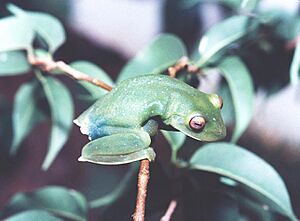Aplastodiscus leucopygius facts for kids
Quick facts for kids Aplastodiscus leucopygius |
|
|---|---|
 |
|
| Conservation status | |
| Scientific classification |
Aplastodiscus leucopygius is a type of frog that lives only in Brazil. It belongs to the Hylidae family, also known as tree frogs. This frog makes its home in warm, wet places. You can find it in forests, near rivers, or even in gardens. It also lives in marshy areas and plantations.
What Does It Look Like?
This frog is about 4 cm (1.6 in) long, which is a medium size for a frog. It has a rounded snout, like a little nose. Males have a single vocal sac on their throat. This helps them make loud calls.
Its eyes have a golden iris with orange edges. You can clearly see its eardrum, which is called a tympanum. Its fingers and toes have special sticky pads. These pads help the frog climb easily.
The frog's back is smooth and green. It has small white spots scattered across it. Its belly is bumpy and cream-colored. It also has tiny white specks. Just above its rear, there's a short, white ridge on its skin.
Where Does It Live?
The Aplastodiscus leucopygius frog is a tree-dwelling species. This means it spends most of its time in trees. It lives only in the mountains of southeastern Brazil. These mountains are high up, between 800 to 1,600 metres (2,600 to 5,200 ft) above sea level. You will mostly find these frogs in forests. They like to be near streams or small, temporary pools of water.
How Do They Have Babies?
These frogs breed during the rainy season. This happens between December and February. Male frogs call from trees to attract a female. They often form a "chorus" with other males. This means many males call together.
When a female arrives, she chooses a male. They perform a special courtship dance. The male then shows the female an underground nest. He prepares this nest in a wet, muddy spot. If the female likes the nest, they mate. She then lays a raft of eggs inside it.
The baby frogs, called tadpoles, stay in the nest. They wait there until the area floods. The floodwaters wash them out of the nest. After that, they continue growing in shallow streams.
Is It Safe?
The Aplastodiscus leucopygius frog is listed as "Least Concern" by the IUCN Red List of Threatened Species. This means it is not currently in danger of disappearing. It is a common frog and lives in many places. Its population seems to be stable. This frog is also very adaptable. It can live in its natural forest home. But it can also live in clearings, forest edges, plantations, and even gardens.


